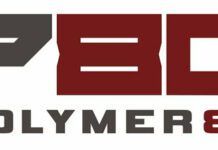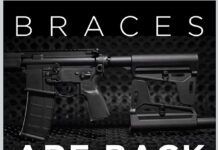We have occasionally dipped our toes in the very shallow pool that is single-shot or bolt-action handguns, beginning as far back as March 1998, in which we tested three single-shot 223 Remington-chambered handguns, the Thompson/Center Encore, Thompson/Center Contender, and Magnum Research Lone Eagle, with our pick being the Encore. Later that same year, we shot an Encore in 22-250 Remington along with bolt handguns from Remington, the XP-100R, and the Savage 510 Striker. The Striker won, with our team saying of it, “This gun looks rougher than the Remington, no question. However, we think its bolt placement gives it an advantage for the right-handed shooter, and the gun may be fired by a lefty just as easily.” In the June 2000 issue, we again looked at 22-250s, this time a Magnum Research Lone Eagle pitted against an Encore and a Savage 510F Striker, with the Savage being called a Best Buy. In September 2003, a Thompson Center Encore in 243 Winchester narrowly beat out a Savage Striker 516SAK for top honors, while an M.O.A. handgun failed to finish the test. So it’s been a minute since we tested this class of firearms, which made it all the more interesting to our Houston test team to examine two handguns chambered in 6.5 Creedmoor, a Christensen Arms Modern Precision Pistol, $2200; and a Savage 110 Pistol Chassis System 57797, $1000. Prices have definitely gone up from our last test, with the winning Encore 243 going for $558 in 2003 dollars.
How We Tested
First, we had to figure out how to test these two pistols. The platform requires optics, but what kind, with what purpose, and for what distance? So, we just tested a bit of everything. The Christensen arrived with a pistol-stabilizing brace mounted on a Picatinny rail at the rear of the receiver. The Savage has a section of Pic rail in the same location, for the same purpose, but does not include the brace. Finding and mounting such a brace is child’s play. An extended brace can be tucked into the shoulder and used as a make-shift stock. But according to the current administration, that is strictly against the rules and could land you in deep trouble. Don’t do it. We didn’t. The extended brace can also be properly wrapped around the forearm and used to stabilize the firearm. This is the legal way to use it, but doing so pushes the firearm further away from the face and necessitates the use of an appropriate optic.

We tested both the Swampfox Justice red dot, $239, and an extended eye-relief 2.75x20mm scope from Burris, $299, designed for scout rifles. Both were effective, though we preferred the red dot to the scope at closer ranges because it was much easier to use. The extended eye-relief reticle is very picky about eye relief, and we found ourselves having to work at it pretty hard to use the Burris. Once we lined it up correctly, however, even the slight amount of magnification was appreciated and useful. We would probably choose the Swampfox red dot for up close work — say 50 yards or so. Then we tried the just-released Crimson Trace 1-10×28 Hardline LPVO (Low Power Variable Optic), $650, and were amazed at what these two pistols could do when configured with LPVO. All groups were shot using the LPVO.
Their new Hardline scope comes with a 1x to 10x magnification range. The low power (1x) actually seems to be very close to a true 1 power. When it is dialed all the way down, our eyes saw very little difference or distortion as we moved from a view with the naked eye and one through the glass. We found the 10x to be more than sufficient for 600-yard shooting, though we yearned for adjustable parallax as we extended the range. Parallax is currently fixed at 100 yards. Still, images were as clear at distance as summertime Texas mirage would allow.
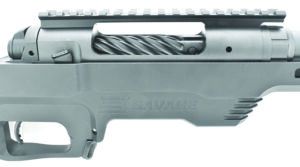
The second-focal-plane reticle means the crosshair size does not change with the magnification. The reticle is illuminated with a lighted inverted “T” at the intersection of the two stadia lines and additional dots at the 1, 2, 3, 4 and 5 Mil lines. The vertical stadia line is segmented between the Mil Dots, making them very easy to see and use. Of course, the second-focal-plane reticle only subtends the correct distances when magnification is cranked up to 10x. Windage and elevation turrets are capped with a zero mark that can be reset. Adjustments to windage and elevation seemed to be crisp and precise. The turrets are unarmored and are best left capped. This unit is designed to be aimed using hold off for distance and wind. That means that the sub tensions on the vertical stadia needed to be very accurate for the scope to work at longer ranges.
We were very pleased with the scope in action, not only doing well at 100 yards, but giving us precise enough holds to nail first-round hits at 417, 505, and 600 yards.
The average group sizes we report to you were collected while shooting these pistols as true pistols. We did not “wink, wink” forget and put the stock up to our shoulders accidentally, rendering both platforms more stable and, thus, even more accurate. We were impressed by what they allowed us to do as pistols. We believe that a real shoulder stock, mounted on either chassis, would be of considerable aid to the shooter. We also realize that would require registration with BATFE as a “Short Barreled Rifle” and a $200 tax stamp. There would also be the hassle of having to notify BATFE anytime the shooter wanted to cross state lines with the NFA weapon. Having said that, we think these two “pistols” were very good options as they arrived and could be superb firearms for backpacking or wilderness hunting.
All testing was done at American Shooting Centers in Houston. For accuracy testing, we fired multiple three-shot groups at 100 yards. All rifles were well-sandbagged in a Caldwell TackDriver Pro test further supported by a heavy rear bag from Tab Gear. We measured velocities with a LabRadar. We sourced our ammo at AmmoGuy.net, securing Norma Match 143 grain rounds along with Hornady 140-grain ELD-M and Hornady 143-grain ELD-X cartridges. Here’s what we found:
Gun Tests Grade: B+
$1000
The Savage Model 110 was first patented almost 60 years ago, and the Savage 110 Pistol is not the first Savage firearm to be mated to a Modular Driven Technology (MDT) chassis. The Savage Pistol Chassis System (PCS) fits the ubiquitous Model 110 action with a short, stiff barrel and mounts everything in the alloy chassis. The resulting pistol measures a mere 21.5 inches in length and weighs 5.75 pounds. That is a hair less than the Christensen and is 2.5 inches shorter without the stock extended on the Christensen.
| Action Type | Bolt |
| Overall Length | 21.5 in. |
| Overall Height | 7.25 in. |
| Maximum Width @ Bolt | 3.25 in. |
| Maximum Width, Chassis | 1.53 in. |
| Weight Unloaded | 5.72 lbs. |
| Weight Loaded | 6.4 lbs. |
| Action Material | Carbon steel |
| Chassis Material | Aluminum alloy |
| Finish | Black |
| Front Strap Height | 3.0 in. |
| Back Strap Height | 4.25 in. |
| Barrel Length | 10.5 in. |
| Receiver Scope-Base Pattern | Picatinny rail |
| Grip Thickness (Maximum) | 1.53 in. |
| Grip Circumference | 5.5 in. |
| Magazine | One 10 round, AICS compatible |
| Trigger Pull Weight | 2.7 lbs. |
| Trigger Span | 2.75 in. |
| Safety | Tang and trigger |
| Warranty | 1-year limited for original owner |
| Telephone | (800) 370-0708 |
| Website | SavageArms.com |
| Made In | U.S.A. |
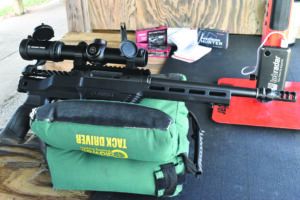
The Savage PCS starts out with a 10.5-inch barrel mated to the receiver with Savage’s customary locking nut. Diameter at the action is about 1.04 inches and 0.74 inches at the muzzle. Where the Christensen ends with a 12-port muzzle brake, the Savage’s barrel ends with 5⁄8×24 threads and a cap to cover them. Even though this pistol is chambered in the mild-kicking 6.5 CM, rearward movement could be a real issue, especially if the shooter chooses a standard-eye-relief scope. Red dots and extended eye relief optics did not create any concern for us as far as protecting our eyebrows. We found this out by shooting the Savage without a muzzle brake, with a Dead Air brake, and then with a Dead Air Sandman S suppressor. We found that if we wanted to shoot this pistol with the Crimson Trace 1-10x optic we eventually decided upon, we really needed to hold onto the grip and lock our wrists. The Dead Air muzzle brake (which also serves as a QD mount) was loud but very effective. The suppressor was magic. It cut down the recoil substantially while lowering the noise from the shot about 40 decibels. We also noted that the brake lowered the velocity 42 fps, and the can brought it down 27 fps. That is a slight loss in energy, but the recoil and noise mitigation were well worth it.
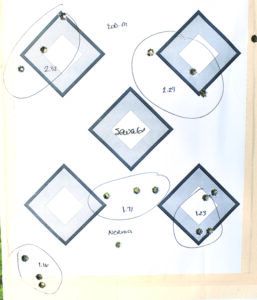
The Savage action is made of steel and should look very familiar to anyone who has worked with a Savage before. The company added a 0-minute-of-angle Picatinny rail well attached to the top of the receiver. This pistol is still right-hand eject, but the bolt is set up to be worked by the left hand, allowing the right hand to stay on the grip while the action is cycled. Major kudos to Savage for that one. The twin-lugged bolt is fluted and can be removed by simultaneously pressing the trigger (please check to make sure the chamber is empty first) and a tab located on the right side of the receiver between the bolt handle and the ejection port. The Accu-Trigger is adjustable from about 2.5 to 6 pounds. Using our Lyman digital trigger scale, our Savage’s trigger measured 2.7 pounds across 10 pulls and had 2.7 ounces of standard variation in those pulls. The safety is a two-position thumb-operated piece located in the 12 o’clock position, immediately behind the bolt shroud.
Everything is then joined to the MDT chassis, which adds some interesting features of its own. The aluminum provides a 7-inch-long fore end with M-Lok slots on the 3, 6, and 9 o’clock flats. The bottom rail comes with a sling swivel stud mounted far forward to facilitate use with a sling or a bipod, such as the great ones from Harris Engineering. Moving to the rear, we come to a large magwell preceded by a barricade stop. This allows the shooter to rest the fore end on some type of support and push the pistol into that support without compromising magazine function. The trigger guard is huge, once again allowing for gloved fingers. The tactical mag release immediately in front of the trigger guard should also be easy to find and manipulate. The pistol grip is bit larger than that on the Christensen and has palm swells, which we liked. The action should be compatible with almost any kind of AR-15 grip. As with the Christensen, the chassis on the Savage ends in a short section of Picatinny rail. Savage does not provide a pistol stabilizing brace of any kind, but they make sure one would be easy to install should the shooter so choose. Two quick detach cups are found at the tail end of the chassis.
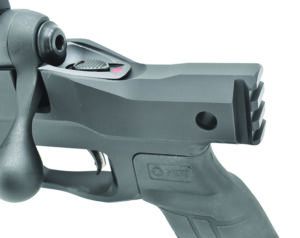
Function and feeding were perfect, as we would expect on a good bolt-action rifle. Once again, we were very pleased with the shooting results. Cumulative average group size across the three types of ammo tested was 1.53 inches. The Savage, for whatever reason, did not like the Hornady 140 ELD-M (2.09 inches for a three-shot group average), but it did like the 143-grain Hornady ELD-X (expanding) round, with an average of 1.14 inches. As mentioned, we tested both with and without muzzle devices. Were we to use the Savage without a brake of some type, we would lean very hard to using a long-eye-relief optic. The Savage, with the shorter barrel, also produced less energy. The least difference between the two pistols was with the Hornady 143-grain ELD-X, with a delta of 172 fps. According to our Applied Ballistics Mobile app, that decrease would shorten our hypothetical “deer-worthy energy” distance from about 450 to 325 yards. Because the average shot on deer in the U.S. is just under 100 yards, that should not make a major difference. Just be aware.
Our Team Said: We did prefer the Christensen Arms pistol, at quite a premium. But this Savage Arms PCS is very good as well, and it’s much more affordable. Of these two, it’s the Better Buy, in our opinion.
| Norma 143-grain Match | Christensen MPP | Savage 110 PCS |
| Average Velocity | 2348 fps | 2141 fps |
| Muzzle Energy | 1738 ft.-lbs. | 1457 ft.-lbs. |
| Average Group | 0.73 in. | 1.37 in. |
| Best Group | 0.57 in. | 1.16 in. |
| Hornady 140-grain ELD-M | Christensen MPP | Savage 110 PCS |
| Average Velocity | 2386 fps | 2189 fps |
| Muzzle Energy | 1770 ft.-lbs. | 1490 ft.-lbs. |
| Average Group | 0.91 in. | 2.09 in. |
| Best Group | 0.74 in. | 1.67 in. |
| Hornady 143-grain ELD-X | Christensen MPP | Savage 110 PCS |
| Average Velocity | 2349 fps | 2172 fps |
| Muzzle Energy | 1753 ft.-lbs. | 1498 ft.-lbs. |
| Average Group | 1.28 in. | 1.14 in. |
| Best Group | 1.07 in. | 0.74 in. |


























